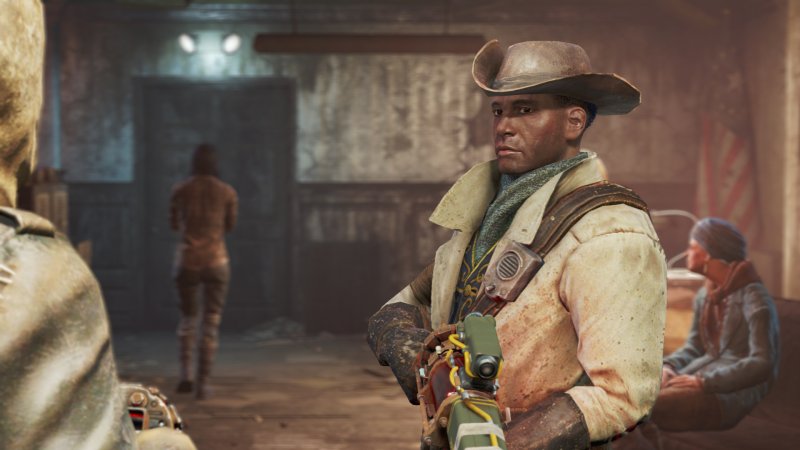Speaking of virtual reality, this 2017 was undoubtedly the year of Bethesda. No other leading manufacturer has invested so much on this still-rugged but apparently full of unexpressed potential. And so, in just a month, we found ourselves three triple A titles with enormous commercial value but with different development objectives. On the one hand there was DOOM VFR,
a virtual experience condensed in a few hours, borrowed from the complete game with recycled environments but with a new narrative arc and a modified gameplay to meet the peculiarities of VR. On the other hand, on the other hand, we found in our hands a complete and only partially adapted version of The Elder Scrolls V: Skyrim,
Bethesda’s pioneering masterpiece that, probably due to its gameplay peculiarities, more easily married the virtual platform without the need for special distortions. And now we’re here to talk about Fallout 4 VR that closely follows the other publisher’s RPG in terms of the breadth of the gaming experience but comes with a much larger set of adjustments to the basic mechanics to meet the controllers and the immersiveness of virtual reality. Although, probably, more than tweaks, we should talk about compromises.
DO NOT CALL IT PORTING
At first glance this could indeed be the noun to be used to define the VR version of Fallout 4: a mere port. The game is, in fact, the one that is intact and complete in its hundreds of hours of primary and secondary quests, with the unaltered environments, the weapons, the equipment and everything else that has characterized this production.
It is also, and above all for this reason that we refer to our review of the original title to have an adequate representation of what it is and above all it is like Fallout 4, given that here we will focus exclusively on the VR version. In reality, however, this adaptation to virtual reality has evidently required a really full-bodied work if we have in mind the structure of the dialogues and above all of the interaction menus that distinguish the fourth chapter of the post-apocalyptic series.
Let’s start with the management of movements that, for a change, is relegated to a teleportation system that seems to have become the common practice of VR videogames.It is always possible to use a direct motion function where the protagonist can walk using one of the two d-pads of the 3D Controller of HTC Vive (or Oculus Rift Touch) but considering the numerous salts and drops of the game map, it is practically impossible do not suffer from motion sickness during game sessions.
Returning then to the obligatory choice of teleportation, we find ourselves faced with a decidedly anomalous mixed situation: navigation is in fact classic with the pressure of the d-pad and the usual navigator that shows us the landing point but has been implemented a consumption of action points connected to this type of movement. In other words, by teleporting we will get tired and, after a couple of “leaps” at the maximum distance,
we will be forced to move very little making longer trips really annoying as we will have to proceed with countless “hops”. Among other things, although it is always possible to turn around with the movement of the head, it is often necessary to rotate the body of the protagonist concretely, especially near obstacles or in the interior,
But unfortunately the difficulties do not end there. Fallout 4 is a game full of menus: the management of loot and inventory, but above all the use of pip-boy arm, are only the most conspicuous elements of a role-playing game that is based very much on the interaction with objects and with statistics.
Managing them with the two controllers alternating the pressure of the triggers to that of the d-pads, sometimes having to use the sliding of the fingers on the touch surfaces, makes these activities extremely cumbersome and very unpleasant especially when you start to spend tens of hours on the title or maybe you find yourself in a room with seven, eight enemies to loot and a dozen shelves and bookstores in which to rummage. And then there’s the beloved-hated pip-boy.
By default it is activated by turning the left wrist, as if you really wanted to observe it, and this operation makes it enlarge to make its screen perfectly legible.
The problem is that the interface of the latter has remained the same identical to the title in the “normal” version and therefore, even here, we find ourselves having to navigate dozens of menus alternating triggers, d-pads and scrolls above. In addition, the aggravating circumference of the rotation of the wrist.
We let you imagine what it means to move through the map or inventory in these conditions. It would be enough to implement a simple touch interface to make everything more immediate. Among other things, in Fallout 4 VR the pip-boy management takes place in real time, without sending the game paused, making this aspect more ruinous.

